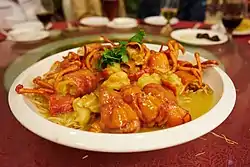 Lobster with e-fu noodles in Hong Kong | |
| Alternative names | E-fu noodles, yee-fu noodles, yi noodles, yifu noodles |
|---|---|
| Type | Chinese noodles |
| Place of origin | China |
| Main ingredients | Wheat flour, eggs |
| Yi mein | |||||||||||||||||||
|---|---|---|---|---|---|---|---|---|---|---|---|---|---|---|---|---|---|---|---|
| Chinese | 伊麵 | ||||||||||||||||||
| |||||||||||||||||||
| Alternative Chinese name | |||||||||||||||||||
| Chinese | 伊府麵 | ||||||||||||||||||
| |||||||||||||||||||
Yi mein (Chinese: 伊麵; pinyin: yī miàn; Cantonese Yale: yī mihn) is a variety of flat Cantonese egg noodles made from wheat flour. They are known for their golden brown color and chewy characteristics. The slightly chewy and slightly spongy texture of the noodles is due to the soda water used in making the dough, which is then fried and dried into flat patty-like dried bricks.
Preparation
The yi mein noodles available at grocery stores were pre-cooked by machines the same way as the modern instant noodles are made.[1]
The noodles may be cooked a number of ways. They are boiled first, then can be stir fried, or used in soups or salads. Good noodles maintain their elasticity, allowing the noodles to stretch and remain chewy.
Dishes
Yi mein noodles can be consumed directly or used in various dishes:
- Plain yi mein
- Plain yi mein with Chinese chives (韮黃)
- Dried fried yi mein (乾燒伊麵), often comes with Chinese chives and shiitake mushroom
- Crab meat yi mein (蟹肉伊麵)
- Lobster yi mein (龍蝦伊麵), it is sometimes served with cheese in Hong Kong.[2][3]
- Yi mein with black mushrooms and eggplant
- Yi mein in soup
- I fu mie, fried yi mein noodles served in sauce with vegetables, chicken or prawn.
Traditions
When yi mein is consumed on birthdays, it is generally referred to as longevity noodles or sau mein (壽麵/寿面). The Chinese character for "long" (長壽麵/长寿面) is also added as a prefix to represent "long life". Usually it is consumed with longevity buns on such occasions.
Yi mein is also a popular Lunar New Year dish. Tradition holds that the chef cannot cut the noodles, and each strand should be eaten whole.[4]
Gallery
 Fisherman style fried yi mein
Fisherman style fried yi mein Western and Chinese style yi mein with lobster
Western and Chinese style yi mein with lobster A bag of yi mein at a store in Yuen Long, Hong Kong
A bag of yi mein at a store in Yuen Long, Hong Kong E-Fu noodle with ground dried shrimp at a Chinese noodle restaurant in Yuen Long, Hong Kong
E-Fu noodle with ground dried shrimp at a Chinese noodle restaurant in Yuen Long, Hong Kong
See also
References
- ↑ "Modern Machine Makes Traditional Yi Mein Noodles". Retrieved 15 July 2023.
- ↑ "Lobster Yee Mein". pigpigscorner.com. 10 June 2011. Retrieved 12 August 2012.
- ↑ "Lobster Yee Mien". www.scmp.com. South China Morning Post. Retrieved 22 October 2015.
- ↑ Maggie Hiufu Wong (19 Jan 2023). "The complicated story behind longevity noodles, a popular Lunar New Year dish". CNN.
External links
- E-fu noodles from The Cook's Thesaurus site